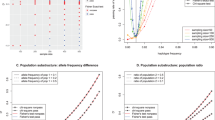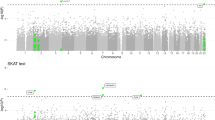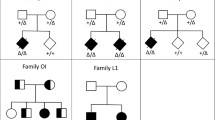Abstract
Stratification in heterogeneous populations poses an enormous challenge in linkage disequilibrium (LD) based identification of causal loci using surrogate markers. In this study, we demonstrate the enormous potential of endogamous Indian populations for mapping mutations in candidate genes using minimal SNPs, mainly due to larger regions of LD. We show this by a case study of the PPP2R2B gene (∼400 kb) that harbours a CAG repeat, expansion of which has been implicated in spinocerebellar ataxia type 12 (SCA12). Using LD information derived from Indian Genome Variation database (IGVdb) on populations which share similar ethnic and linguistic backgrounds as the SCA12 study population, we could map the causal loci using a minimal set of three SNPs, without the generation of additional basal data from the ethnically matched population. We could also demonstrate transferability of tagSNPs from a related HapMap population for mapping the mutation.
Similar content being viewed by others
References
Barrett J. C., Fry B., Maller J. and Daly M. J. 2005 Haploview, analysis and visualization of LD and haplotype maps. Bioinformatics 21, 263–265.
Bahl S., Virdi K., Mittal U., Sachdeva M. P., Kalla A. K., Holmes S. E. et al. 2005 Evidence of a common founder for SCA12 in the Indian population. Ann. Hum. Genet. 69, 528–534.
Grierson G. 1927 Linguistic survey of India. Motilal Banarsidas, Calcutta.
Habib I. 2001 People’s history of India, Part 1: Prehistory. Aligarh Historians Society and Tulika Books, Aligarh.
Habib I. 2002 People’s History of India, Part 2: The Indus Civilization. Aligarh Historians Society and Tulika Books, Aligarh.
Holmes S. E., O’Hearn E. E., McInnis M. G., Gorelick-Feldman D. A., Kleiderlein J. J., Callahan C. et al. 1999 Expansion of a novel CAG trinucleotide repeat in the 5′ region of PPP2R2B is associated with SCA12. Nat. Genet. 23, 391–392.
Indian Genome Variation Consortium 2005 The Indian Genome Variation database (IGVdb), a project overview. Hum. Genet. 118, 1–11.
Indian Genome Variation Consortium 2008 Genetic landscape of the people of India: a canvas for disease gene exploration. J. Genet. 87, 3–20.
Miller S. A., Dykes D. D. and Polesky H. F. 1988 A simple salting out procedure for extracting DNA from human nucleated cells. Nucleic Acids Res. 16, 1215.
Singh K. S. 1998 India’s communities. People of India National Series, Anthropological Survey of India. Oxford University Press, New Delhi.
Stephens M., Smith N. J. and Donnelly P. 2001 A new statistical method for haplotype reconstruction from population data. Am. J. Hum. Genet. 68, 978–989.
Author information
Authors and Affiliations
Consortia
Corresponding author
Additional information
Composition first described in Hum. Genet. 2005, 118, 1–11
Rights and permissions
About this article
Cite this article
Bahl, S., Ahmed, I., The Indian Genome Variation Consortium. et al. Utilizing linkage disequilibrium information from Indian Genome Variation Database for mapping mutations: SCA12 case study. J Genet 88, 55–60 (2009). https://doi.org/10.1007/s12041-009-0007-0
Received:
Revised:
Accepted:
Published:
Issue Date:
DOI: https://doi.org/10.1007/s12041-009-0007-0




